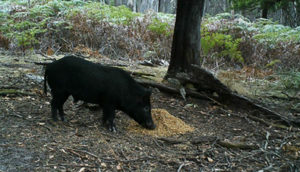Read the latest information on
Foot-and-mouth disease
 With pressures on our biosecurity system always growing, matching these threats with increasing awareness and investment is a top priority for governments and industry bodies. The Australian government recently announced further support for a steering group and a highly experienced coordinator to lead efforts against feral pigs, that can leverage off the renewed national framework for the management of wild dogs. The two frameworks and action plans will be quite complimentary and strengthen both initiatives and their outcomes.
With pressures on our biosecurity system always growing, matching these threats with increasing awareness and investment is a top priority for governments and industry bodies. The Australian government recently announced further support for a steering group and a highly experienced coordinator to lead efforts against feral pigs, that can leverage off the renewed national framework for the management of wild dogs. The two frameworks and action plans will be quite complimentary and strengthen both initiatives and their outcomes.
Because investments like these are critical to livestock industry sustainability, Animal Health Australia (AHA) is eager to remind landowners of the important role they can play in ensuring that national efforts to control feral animals gain traction and are as effective as possible in their own neck of the woods.
“Feral pigs alone cost our agricultural industries millions of dollars a year, through loss of livestock, destruction of crops, and fouling and damage to farm infrastructure,” said Senior Manager Biosecurity, Dr Rob Barwell.
“They also carry a number of diseases of high concern, such as Brucella suis; that’s not to mention the potential role they could play in the spread of foot and mouth disease or African swine fever – were those diseases breach Australia’s biosecurity measures and break out here.
There are many strategies involved for dealing with wild pigs, dogs, deer and other feral animals, including lethal controls, trapping programs, exclusion fencing and use of protective animals.
While national strategies and frameworks exist to provide a guide, it is these on-the-ground activities which form the bulk of the push to manage the impacts of feral animals when eradication is not economically viable.
“Regardless of how you choose to do it, it’s no surprise that a feral animal control program needs the support of your neighbours,” Dr Barwell explained.
“If you choose to go it alone it’s likely a breeding population will find refuge on nearby properties or public land, or your timing could be out compared to other coordinated efforts in your area.”
Researchers and coordinators are constantly trialing new methods and sharing what they have learned from landowners and land managers in other regions. Working with them or following their work can lead you to proven tactics, such as cluster fencing, and the latest research on topics such as optimum deployment of baits.
“Our industries and conservationists rely on those at the front lines, so to speak, to use what we’ve learned to address the ongoing challenges that feral animals pose for landowners and land managers,” Dr Barwell said.
“Work with your neighbours, work with the experts, participate in local management groups and keep up the momentum in the push to reduce these impacts on our industries and our natural landscape.”
Find out more about controlling feral animals as part of your biosecurity plan at the Farm Biosecurity website.
Find out the latest on controlling specific feral animals at PestSmart.